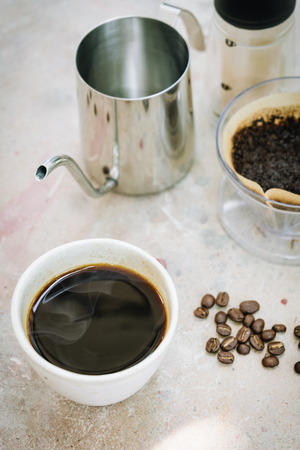Introduction to the British Cafetière Ritual
The cafetière, or French press as it’s sometimes known, has carved out a distinctive niche within Britain’s vibrant coffee culture. Its arrival on these shores in the latter half of the twentieth century marked a subtle revolution on the breakfast table—a departure from instant granules and percolators to a more elegant, hands-on brewing experience. The ritual of pressing down the plunger over freshly steeped grounds soon became synonymous with leisurely Sunday mornings and chic brunch gatherings. In a society renowned for its tea traditions, the cafetière quietly asserted itself, blending continental sophistication with British sensibility. Today, whether nestled amongst marmalade jars and toast racks or serving as the centrepiece at trendy café brunches, the cafetière is cherished not only for its rich, robust coffee but also for the unhurried pleasure it brings to daily rituals across the UK.
2. Tradition Meets Modernity: Evolving Coffee Preferences
In the United Kingdom, where the clink of teacups has echoed for centuries, the cafetière—known elsewhere as the French press—has quietly brewed its way into British homes and cafés, serving as a bridge between time-honoured traditions and modern tastes. While tea remains an enduring symbol of British culture, the rise of artisanal coffee has invited a new ritual to the table, one that celebrates both heritage and innovation.
The cafetière offers a tactile brewing experience reminiscent of afternoon tea ceremonies, yet it brings with it a sense of continental sophistication. Unlike the swift convenience of instant coffee or the elaborate machinery behind espresso, using a cafetière is an act of patience and care: coarsely ground beans are steeped, pressed, and poured in a process that encourages pause and appreciation. This mirrors the mindfulness associated with making a proper cup of tea, allowing Britons to savour their drink and the moment alike.
As preferences evolve, the cafetière stands at the crossroads of tradition and trend. It appeals to those who cherish ritual but also seek quality and authenticity in their cup. The following table illustrates how the cafetière compares with traditional British tea preparation and modern coffee-making methods:
| Beverage Ritual | Key Equipment | Time Required | Cultural Significance |
|---|---|---|---|
| Traditional Tea | Teapot, Strainer | 5-7 minutes | Symbol of hospitality and comfort; daily ritual |
| Cafetière Coffee | Cafetière (French press) | 4-6 minutes | Blends continental flair with British appreciation for ceremony |
| Espresso-Based Coffee | Espresso machine | 1-2 minutes | Modern, urban; associated with café culture and “grab-and-go” lifestyles |
This seamless integration is reflected in British kitchens across generations. While older family members may reach for their Earl Grey or breakfast blend, younger coffee aficionados are just as likely to reach for ethically sourced beans and their trusty cafetière. The result? A uniquely British brew that respects tradition while embracing contemporary taste—a testament to how the nation’s love for warm drinks continues to evolve without losing its signature charm.

3. The Cafetière in Daily British Life
Step into any British home on a crisp morning and you are likely to find the comforting aroma of freshly brewed coffee wafting from a cafetière perched on the kitchen counter. For many, this humble piece of kit has become as essential to the breakfast table as marmalade or toast. Unlike the hurried drip machines found elsewhere, the cafetière invites a slower, more considered approach—one that fits seamlessly with Britain’s cherished ritual of taking time over one’s first cup. It’s not just about caffeine; it’s about ceremony. The act of pressing down the plunger, waiting for those few crucial minutes, and pouring out the rich, aromatic brew is a gentle start to the day, often shared with family around the table or enjoyed solo with the morning papers.
The cafetière also holds its own during social gatherings—a centrepiece at brunches, book clubs, and even in garden get-togethers under drizzly skies. In a culture where tea has long reigned supreme, offering guests coffee from a cafetière feels both invitingly continental and unmistakably modern British. It signals an appreciation for quality and conviviality, bridging generations and tastes. Whether it’s a neighbour popping in for a quick chat or friends lingering over pastries on a Sunday morning, serving coffee from a cafetière brings an unhurried elegance to every occasion—a subtle nod to Britain’s evolving but ever-hospitable approach to hosting.
4. Social Connection and Coffee at Home
Within the fabric of British life, the cafetière has quietly established itself as a centrepiece for social connection at home. Unlike the fleeting grab-and-go espresso shots or takeaway cups, sharing a pot of coffee brewed in a cafetière is synonymous with taking time—something that resonates deeply with British sensibilities around hospitality and togetherness.
Whether it’s the classic Sunday roast with family or an impromptu catch-up with friends, the act of preparing and serving coffee from a cafetière invites conversation to linger. There’s a certain ritual to pressing down the plunger and pouring each cup, a gentle encouragement to slow down and savour both the brew and the company. This ritualistic quality makes the cafetière more than just a coffee maker; it becomes a vehicle for warmth, connection, and shared experience.
The Cafetière: A Modern British Social Ritual
| Occasion | Cafetières Role | British Cultural Element |
|---|---|---|
| Sunday Roast | Served after lunch as an invitation to linger around the table | Emphasis on family time and relaxed gatherings |
| Afternoon Catch-Up | Brewed for guests as a gesture of welcome and care | Traditional hospitality and friendliness |
| Book Clubs & Hobbies | Shared among group members to spark discussion and comfort | Encourages open conversation in informal settings |
| Special Celebrations | Poured alongside dessert or cake to mark moments big or small | Ceremony and ritual woven into daily life |
The versatility of the cafetière means it effortlessly adapts to various social occasions, bridging generations and styles. For many, it’s not just about the coffee but about creating space for genuine interaction—a cornerstone of British domestic culture. The gentle clink of mugs, the aromatic steam rising from freshly brewed grounds, and the soft hum of conversation all come together to create an atmosphere where memories are made and stories are shared.
5. Sustainability and Style: Why the Cafetière Endures
In an era where eco-consciousness is at the forefront of British lifestyles, the cafetière stands as a symbol of both sustainability and refined taste. Unlike single-use coffee pods or the endless stream of takeaway cups that fill city bins each morning, brewing with a cafetière generates virtually no waste—just grounds that can be composted in any suburban garden or urban allotment. For many Britons, this mindful approach to coffee preparation aligns perfectly with a growing desire to reduce single-use plastics and minimise environmental impact.
But it’s not just about being green; there’s an undeniable style factor at play. The cafetière, often crafted from gleaming glass and stainless steel, looks at home in both chic London flats and cosy countryside cottages. It speaks to a certain appreciation for timeless design—a nod to continental café culture that has been seamlessly woven into British daily rituals. Its presence on the breakfast table or during a weekend brunch telegraphs taste and intention, suggesting that the host values both their guests and the quality of their brew.
The ritual itself becomes part of the appeal. Preparing coffee in a cafetière encourages you to slow down: to savour the aroma as you stir, to watch the grounds bloom and steep, and to enjoy a few moments of calm before plunging. This stands in sharp contrast to the hurried act of grabbing a flat white on the go or pressing a button on an electric pod machine. In Britain’s fast-paced cities and peaceful villages alike, these small rituals offer a chance to reconnect—with yourself, your company, and the simple pleasure of good coffee.
Ultimately, the enduring popularity of the cafetière in British coffee culture is down to its unique blend of sustainability, elegance, and ritual. It offers an antidote to disposable habits and fleeting trends—proof that sometimes, the classic methods are not only more stylish but also kinder to our planet.
6. The Modern British Coffee Table: A Visual Icon
The contemporary British coffee table is far more than just a practical surface for resting mugs and morning newspapers. At the heart of this domestic tableau sits the cafetière—an object that has transcended its original purpose to become a visual icon of British style, design, and homely comfort. In homes across the UK, the cafetière is displayed with pride, its sleek glass and stainless steel silhouette reflecting both a taste for European aesthetics and a uniquely British sense of hospitality.
The Cafetière as a Design Statement
Whether nestled amidst glossy lifestyle magazines or standing centre stage during weekend brunches, the cafetière serves as an expression of personal taste. British households often select their cafetières not only for functionality but also for how well they complement their interior décor—be it modern minimalism or classic country chic. Its presence on the table signals a considered approach to daily rituals and a celebration of beautiful, purposeful objects.
A Symbol of Comfort and Community
Beyond its design credentials, the cafetière embodies what many cherish about British culture: warmth, familiarity, and conviviality. Gathering around the coffee table with a freshly brewed pot fosters conversation and connection—a ritual that feels especially meaningful in today’s fast-paced world. It’s this blend of practicality and emotional resonance that cements the cafetière’s place in British coffee culture.
Celebrating Everyday Luxury
To celebrate the cafetière is to honour those small moments of everyday luxury that make British life distinctive. Each use becomes an opportunity to slow down, savour good company, and appreciate thoughtful design. As both a trusted tool and a symbol of domestic elegance, the cafetière continues to shape the experience of coffee at home—reminding us all that style and comfort belong at every British coffee table.


